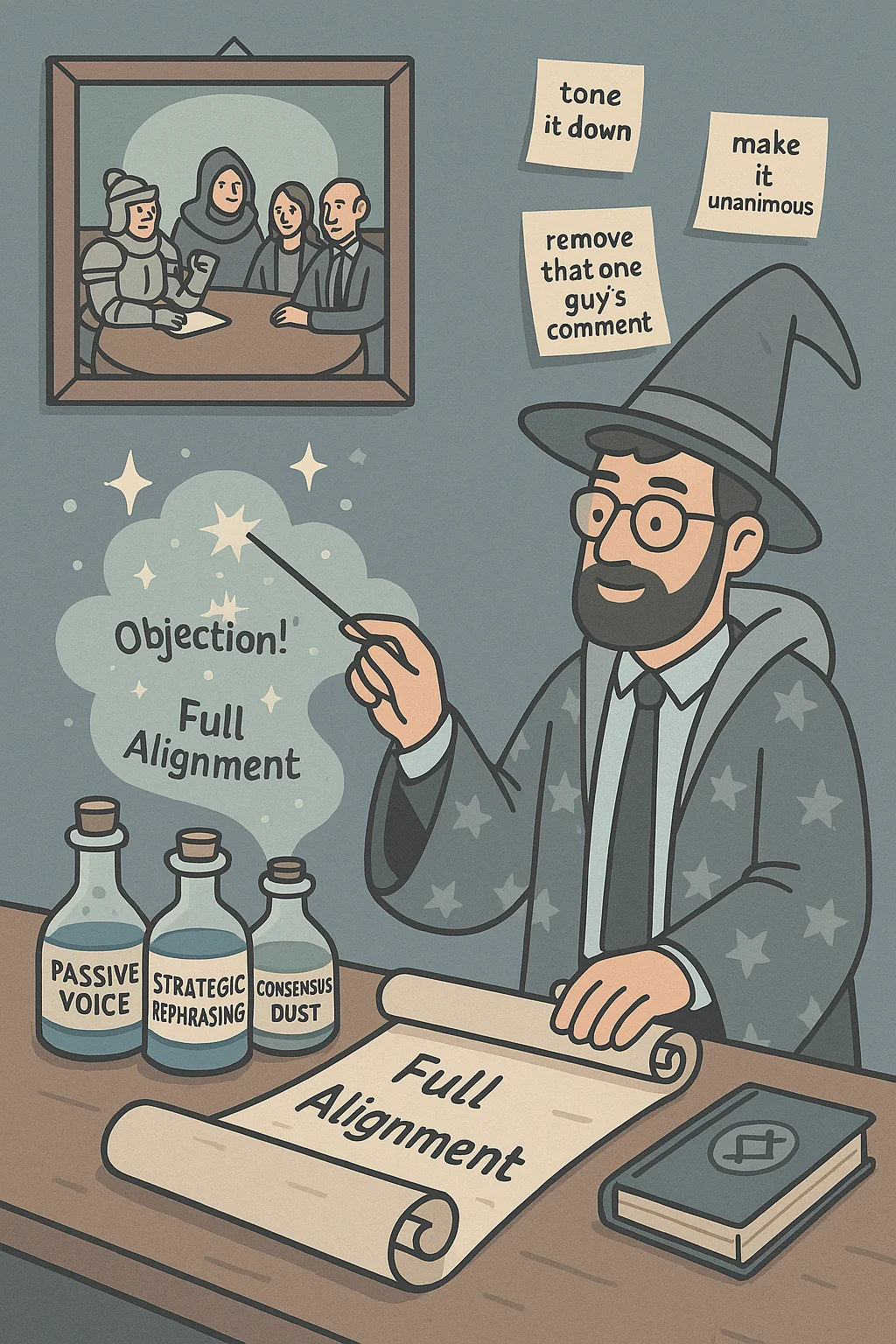· I'mBoard Team · general · 6 min read
5. 📢 How to Gaslight Your Board with Delayed and Rewritten Meeting Minutes
In this satirical guide to startup governance dysfunction, we explore how to delay, rewrite, and distribute conflicting board minutes to keep your board guessing—and your D&O insurance for startups trembling. If your last board meeting ended with “action items,” this post will help you turn them into vague memories instead.

From “Did we really approve that?” to “I’m pretty sure I blacked out.”
🚨 Disclaimer: This guide is purely satirical and intended for entertainment purposes only. Any attempt to follow this advice might significantly increase friction with your board of directors, complicate your startup governance, or void your D&O insurance for startups. Proceed responsibly—or better yet, don’t.
🪑 When in Doubt, Rewrite the Past
Welcome back to The Startup CEO’s Guide to Mastering Boardroom Chaos, the only leadership series brave enough to say what everyone’s thinking—but in a satirical tone that lets us all pretend we’re joking.
Today, we turn our attention to that unsung post-meeting power play: the board minutes.
Let’s be honest—your investors are lovely people with sharp questions, long memories, and an unsettling obsession with “accountability.” After every board meeting, they might be tempted to follow up. Ask for data. Refer to things you promised. Heaven forbid, hold you to them.
But what if—just what if—you could buy yourself a little breathing room? What if your board spent less time scrutinizing your roadmap and more time wondering whether they dreamed that roadmap up themselves?
That’s where the minutes come in.
This isn’t about malicious intent. You’re not trying to deceive anyone. You’re simply reshaping the narrative into something more… manageable. A slight delay here, a strategic rephrasing there, and suddenly your board isn’t quite sure what they agreed to—but it sounds plausible. And with any luck, they’ll start questioning their own recollection instead of your decision-making.
In this fifth installment, we’ll explore how to delay, edit, and reinterpret board minutes to maintain your most valuable asset: plausible deniability.
You’re not gaslighting. You’re just protecting everyone’s mental health—and, arguably, your D&O insurance for startups.
🕰️ 1: Delay Is the Best Policy
Let’s start with the basics: timing. The golden rule of board minutes is to never let them arrive while the board still remembers what actually happened.
Ideally, don’t send them at all. Just let them drift silently into the same administrative black hole as your Q3 hiring plan. But if someone follows up (usually that one board member who treats governance like it’s a hobby), then and only then—send them. Casually. Two months late. On a Friday. At 6:45 PM.
To maximize confusion, vary the format each time:
- A Google Doc with “Suggestions” left unresolved.
- A PDF titled final_FINAL_draft_approved_NOT.pdf
- A screenshot of your handwritten notes, taken at an angle that shows mostly your laptop keyboard.
- A Slack message with no context: “Attaching minutes here (pls disregard typos)”.
This tactic achieves two things:
- Your board will spend the first 10 minutes of the next board meeting discussing where the minutes are.
- By the time they finally read them, the moments they’re meant to document will feel like a fever dream.
Sample Boardroom Dialogue:
Board Member: “Did anyone ever receive the minutes from the April meeting?”
CEO: “Pretty sure I sent them.”
Board Member: “To whom?”
CEO: “I think I shared the Google Drive link in the calendar invite comments.”
Board Member: “The meeting invite that got deleted?”
CEO: “Exactly.”

✍️ 2: “As Agreed…” – Your Magical Phrase for Inventing Consensus
There are few phrases in the English language more powerful than “As agreed.” It’s short. It’s confident. And best of all, it makes everyone feel like they missed something—but that it’s probably their fault.
Board members hate appearing forgetful. So when you preface a bombshell decision with “As agreed by the board…” in the minutes, most won’t challenge it. They’ll just assume they zoned out during one of your 27-slide budget walkthroughs.
Pro tip: attribute decisions to absent members—especially if they’re in favor of it.
Sample Boardroom Dialogue:
Investor: “Why do the minutes say we approved a TikTok influencer campaign?”
CEO: “As agreed in the meeting.”
Investor: “I thought we said we’d review it later.”
CEO: “Right. And we agreed that I could proceed in the meantime.”

🛠️ 3: Fix It in Post – Rewriting Reality One Line at a Time
Now that the board meeting is over, it’s time to shape that chaos into a polished, unanimous outcome.
Welcome to the world of creative transcription, where board minutes become your tool for post-meeting refinement. Omit objections. Condense debate into consensus. Upgrade passing remarks into full-blown strategy.
Also, always remember to use passive voice:
- “It was decided…”
- “Consensus appeared to emerge…”
These phrases are your safety net. No fingerprints. No accountability.
Sample Boardroom Dialogue:
Board Member: “This says we unanimously supported the new sales commission plan?”
CEO: “Yes, after a robust discussion.”
Board Member: “I said it was a terrible idea.”
CEO: “And I deeply appreciated that input. It helped us refine the plan we ultimately aligned on.”
Board Member: “…I’m going to start recording these meetings.”
🧠 4: One Board, Many Minutes – Divide and Confuse
If you truly want to sow long-term doubt, don’t stop at rewriting—fragment.
Send multiple versions of the board minutes:
- Finance gets one version.
- The observer gets a redacted version.
- The new investor gets the “clean” PDF—missing pages 3–4.
Never use centralized storage. Let every board member maintain their own archive of half-remembered board meetings, saved under filenames like:
Minutes_final_v3_latest_edits_revised_FOR_APPROVAL_but_not_final.pdf
And when a new board member joins?
Just forward a handful of disjointed emails and say, “This should give you the context.”
Sample Boardroom Dialogue:
New Board Member: “Is there a central archive of past minutes?”
CEO: “Kind of. They’re all in email. Just search your inbox for ‘minutes’ and ignore the ones marked ‘draft’ or ‘pls disregard.’”
New Board Member: “…but I wasn’t on the distribution list back then.”
CEO: “Ah. Then you probably missed the context.”

🎬 Closing: Reality Is Overrated Anyway
And there you have it—your crash course in minute-based misdirection.
By mastering the fine art of strategic delays, creative phrasing, selective editing, and chaotic distribution, you’ve not only redefined how board minutes are written—you’ve redefined time itself. Who said governance had to be linear?
With any luck, your board members now spend their days wondering whether they’re misremembering, overlooking, or simply not smart enough to keep up. Which, let’s be honest, is far more productive than asking what actually happened in the last board meeting.
Remember: the goal isn’t deception. It’s a calmer, quieter boardroom… achieved through mild disorientation and administrative sleight of hand.
Coming up next in The Startup CEO’s Guide to Mastering Boardroom Chaos:
📋 6. The Art of the Surprise: How (Not) to Sync Board Members Before Meetings



